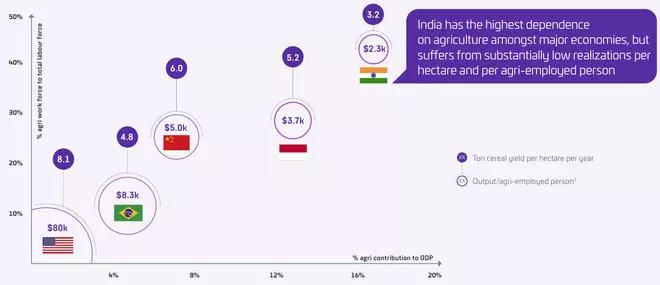Tilling the soil: How private market investments can bolster Indian agriculture sector’s growth
From a gracious 54 per cent in the 1950s to 35 per cent in the 1990s and a mere 15 per cent in 2023, the share of Gross Value Added (GVA) of the Agriculture and Allied sectors to the Indian economy has witnessed a staggeringly declining trend. Despite its shrinking share, the sector remains significant to the economy owing to its magnitude.
%of GVA of agriculture and allied sectors in the total economy (bars) and growth of agriculture and allied sectors (in line graph)
If we compare the GVA of Indian Agricultural and Allied sectors to the Gross Domestic Product (GDP) of the current BRICS nations, the GVA of the sector surpasses the GDP of countries such as the UAE, Egypt, Iran, South Africa, and Ethiopia, demonstrating its magnitude and emphasising why agriculture remains vital to the Indian economy despite losing ground to the manufacturing and services sectors. Even in terms of human capital, agriculture surpasses the populations of many countries, including Iran, the UAE, and South Africa, employing around 46 per cent of India’s total labour force, approximately 252 million.

Indian Agriculture & Allied sector GVA vs BRICS members’ GDP (excluding China) | Source: World Bank GDP Data as of 2022

Source: Agfinder – Investment report – globas
5 reasons
Despite its massive role in the Indian economy, the country’s agricultural sector significantly lags in productivity compared to its global counterparts. Among the various reasons, we can identify the following five as paramount causes that require extensive attention to enhance the overall productivity of Indian agriculture:
· Limited accessibility to high-quality inputs.
· Lack of awareness regarding soil testing and advisory tools.
· Limited understanding among farmers about crop and cattle insurance.
· Lack of standardized practices in the cattle trading market.
· Leakage and wastage due to inefficient processes.
While efforts have been made in the past to address these issues, including government policies, thoughtful investments, and innovative initiatives by entrepreneurs, there is still ample room for improvement and growth.
Private market investment trends in Indian agriculture
Private market investments in the agricultural sector are crucial. They offer more flexibility and longer-term strategic support than public market investments, enabling agricultural enterprises to navigate industry-specific challenges with agility and resilience.
However, let’s look at the data from the Indian private market investments. We find a significant discrepancy in investment distribution among the subsectors, with the Agriculture Supply Chain and other downstream startups receiving the majority share at 67.1 per cent, followed by the agri marketplace and fintech subsector with 17.4 per cent. The rest of the sub-sectors lack adequate capital allocation, indicating potential areas for growth or underexplored opportunities.
In the US, agri-biotech and innovation received the largest share of investments (43.9 per cent), followed by Downstream supply chain technologies (33.0 per cent) and farm mechanisation and technology Support (9.1 per cent) over the same period. Such investments in upstream activities have led to increased yield per hectare and output per agri-employed person. In contrast to this, an emerging market like India has its investments concentrated in downstream supply chain startups, and our yield per hectare and output per agri-employed person is comparatively much lower than the US. This comparison should make us rethink our approach toward investments in agriculture startups.

Private Investments in Agriculture and Allied Sectors
Conclusion
I agree that the agricultural supply chain has its own challenges that require investments to improve and increase farmer income and reduce post-harvest losses. However, focusing on upstream activities such as agri-biotech, innovative farming techniques, and farmer-friendly agricultural financing options is equally important to enable higher-quality production, long-term sustainability, and resilience in the face of climate change and resource limitations.
We need to bolster our agricultural practices and processes at the source to enable the growth of agriculture and empower our farmers truly. India has the potential to emerge as a global leader in sustainable agriculture, ensuring food security, economic prosperity, and environmental stewardship for generations to come. A long-term approach is required towards agriculture in India for the sector’s true potential to be achieved. Targeted investments in the right resources and concerted efforts hold the key to harvesting this potential that can be achieved by tilling the soil of thoughtful development today, laying the foundation for a sustainable tomorrow.
Agarwal is Founder and CEO, while Ajay Raja is Senior Analyst, C4D Partners
